If there is one winner this year, it’s probably video.
With everyone online all the time in 2020, video became more crucial than ever for marketing and communication. And it’s not showing any signs of slowing down.
At Biteable, the world’s simplest video maker, we’ve seen the number of videos made shoot up as more and more people turn to video to elevate their messages. Even Instagram, once synonymous with photo sharing, has declared it’s preference for video.
To help us gauge how important video has become for marketers, we surveyed 694 marketers and small business owners using SurveyMonkey Audience. Here’s what they said.
- Did you know
You’re welcome to share any of our survey statistics. Please link to Biteable as the source.

Marketers use video a lot
We surveyed people across a broad range of roles. Marketers use video the most out of them all.
60% of businesses use video as a marketing tool.
50% of marketers who use video have done so for over a year.
36% of marketers make videos a few times a week, while 14% make videos every day.
94% of marketers who use video plan to continue.
Not only marketers are using video
Marketers aren’t the only ones using video in their roles. Video is used widely across all departments.

32% of businesses use video for sales.
29% of businesses use video in their administration and operations messages.
27% of businesses use video in their human resources messages
24% of businesses use video in their leadership messages.
20% of businesses use video in their product management messages.
19% of businesses use video in their customer support messages.
10% of businesses use video in their finance department messages.

Video marketing is effective
For marketers, video is an essential part of their toolkit. For many, video outperforms other marketing tools.
61% of marketers see video as a “very important or extremely important” part of their marketing strategy.
30% of marketers see video as a more important part of their strategy than their website.
74% of marketers say video has a better return on investment than static imagery.
68% of marketers say video has a better return on investment than Google Ads.
53% of marketers say that video helps them raise awareness.
49% of marketers say that video helps them engage their audience.
52% of marketers say that video helps them build trust with potential customers.
YouTube has the best ROI for video content, followed by Facebook and Instagram.
How marketers make videos
Video making is a collaborative process. The tools and skill levels employed vary widely.

75% of businesses make videos as a team.
39% of marketers make videos in-house, while 17% continue to fully outsource video creation.
58% of marketers make videos with professional software, while 49% use easy online tools like Biteable.
38% of marketers use smartphone apps to produce videos.
35% of marketers make videos from scratch each time, while 18% use pre-made templates. 48% use a mix of both.

Video making perceptions
Video making is perceived as being hard to do. Most people think that multiple skills are needed.
66% of marketers don’t make videos because they think it’s too time-consuming.
41% of marketers don’t make videos because they think it’s too complicated.
37% of marketers don’t make videos because they think it’s too expensive.
80% of marketers would create more videos if they knew an easy way (like biteable.com).
How much marketers spend on videos
The amount marketers spend on their videos ranges widely, with the majority spending at the low end of the spectrum.

Most marketers spend between $100 and $1000 on average per video.
In 2020, most marketers spent $300 or less on video

What marketers put in their videos
Captions, voiceovers, and music are must-haves for marketing videos, of which the most popular types to make are presentations and ads.
The most common types of videos made by marketers are presentations (65%), followed by ads (57%), and explainers (47%)
81% of marketers say their videos perform better with music.
66% of marketers say their videos perform better with a voiceover.
64% of marketers say their videos perform better with captions.
78% of marketers say their videos perform better with less text.
65% of marketers say it is either “very important” or “extremely important” to show diversity in videos.
Half of marketers (50%) use a social media calendar to generate video ideas.
Where marketers host and publish videos
Free platforms are the place marketers prefer to post their videos, with Facebook being the most popular social channel for posting videos.

Most marketers host their videos on free social platforms like YouTube (51%), followed by paid video hosting (17%), and self-hosting (23%).
66% of marketers say their videos perform better with a voiceover.
Most marketers (34%) post their video content to social platforms in the afternoon. Evening is the next most popular (25%), followed by morning (22%). The least post at night (2%).
Appendix: Survey graphs
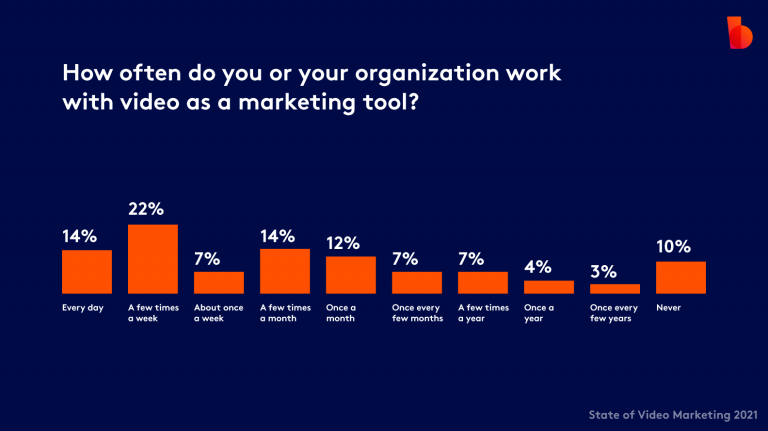
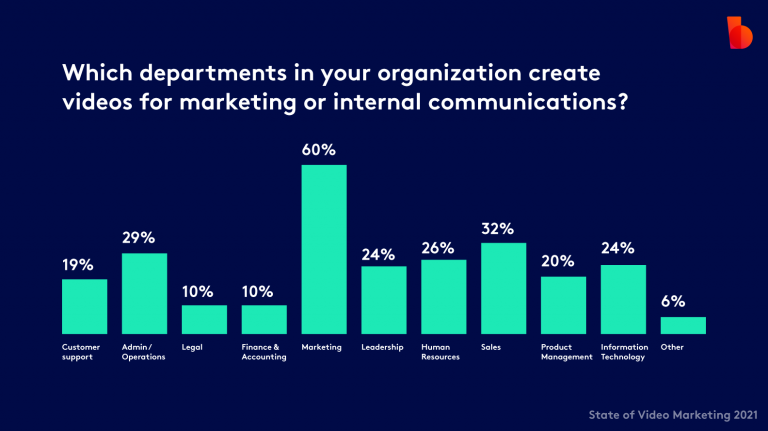
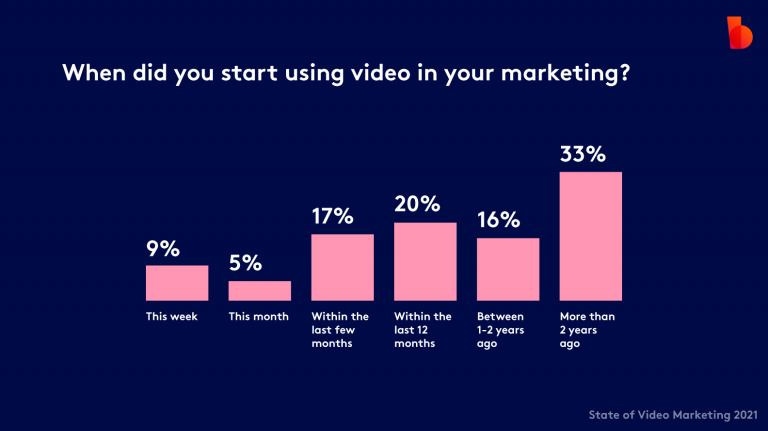

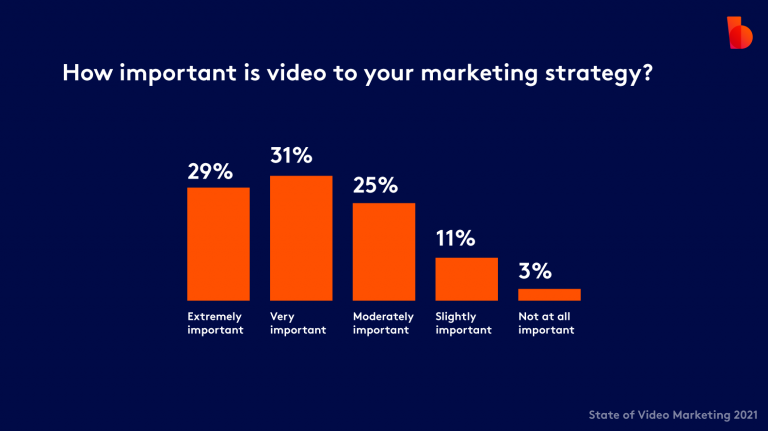


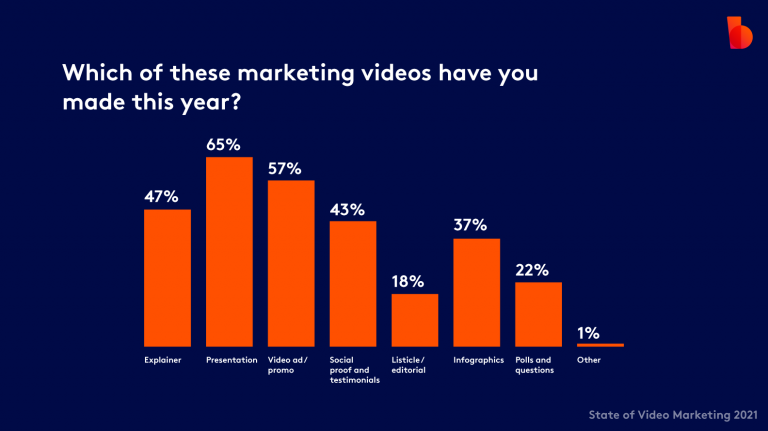
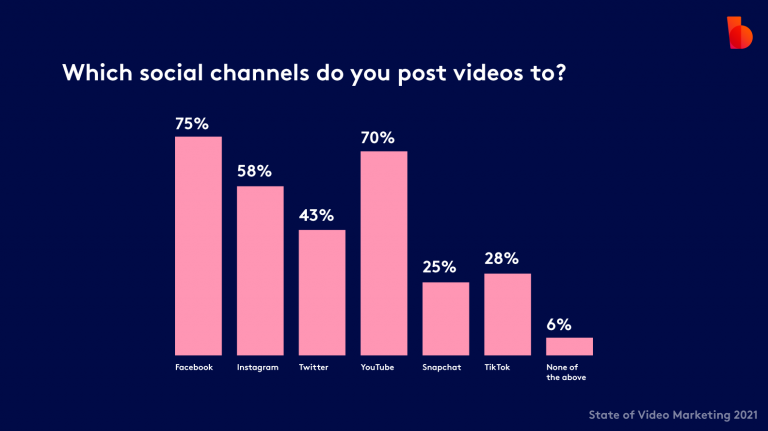
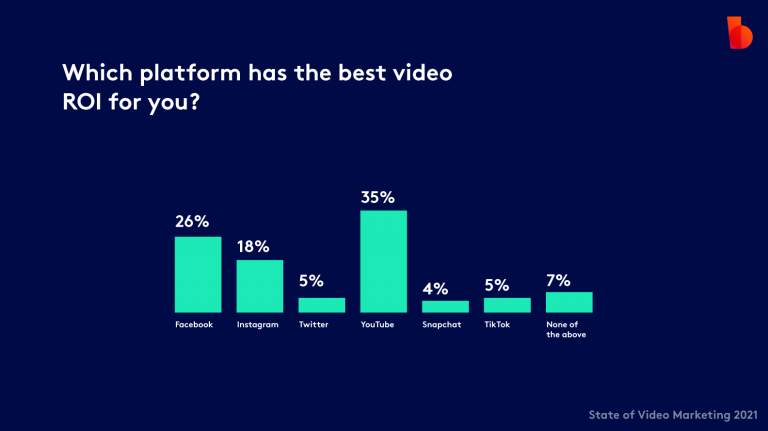
More video marketing stats
Now that you’re caught up on the Biteable stats, let’s take a look at what everyone else is saying about video marketing in 2021.
To showcase just how important video content is in the digital world, we’ve also compiled a list of the latest social media video marketing statistics from around the web. Video marketers, take note.
Video trends
Video is here to stay. Even Mark Zuckerberg believes video is a critical part of our future. The sheer volume of video content online is growing exponentially, as these stats demonstrate.
86% of businesses use video as a marketing tool — up from 63% in 2019. (Hubspot)
6 out of 10 people would rather watch online videos than television. (Google)
Mobile video consumption rises by 100% every year. (Insivia)
By 2022, online videos will make up more than 82% of all consumer internet traffic — 15 times higher than it was in 2017. (Cisco)
78% of people watch online videos every week, and 55% view online videos every day. (HubSpot)
YouTube is the second most popular website after Google. (Alexa)
Users view more than 1 billion hours of video each day on YouTube. (YouTube)
59% of executives say they would rather watch a video than read text. (Wordstream)
75% of all video plays are on mobile devices. (eMarketer)
Viewers retain 95% of a message when they watch it in a video, compared to 10% when reading it in text. (Insivia)
72% of customers would rather learn about a product or service by way of video. (HubSpot)
People are 1.5 times more likely to watch video on their mobile phones. (Facebook)
92% of users watching video on mobile will share it with others. (Wordstream)
- One million minutes of video crosses the internet every second. (Cisco)
Social video statistics
As more social networks follow Facebook’s lead and prioritize video content, the importance of video messaging across all channels has increased.
65% of people use YouTube to help them solve a problem. Want to build a house or remove weird parasites from your eye? YouTube might have the answer. (Google)
45% of Twitter users want to see more videos from celebrities. (Twitter)
90% of Twitter video views happen on a mobile device. (Twitter)
Over 1.9 billion people use YouTube. That’s about one-third of the internet. (YouTube)
The highest earner on YouTube made $29.5 billion last year. He’s 9 years old.
YouTube has 2.3 billion users worldwide (and counting!) (Oberlo)
62% of people said they were more interested in a product after seeing it in a Facebook Story. (Marketing Land)
Facebook has over 8 billion video views per day. (TechCrunch)
75 million people visit Facebook’s video platform every day. (Adweek)
Social video generates 1200% more shares than text and image content combined. (G2 Crowd)
Video promotions are now equally as popular as photo promotions on Facebook. (Socialbakers)
Snapchat users watch 7 billion videos each day. (The Frank Agency)
More than 1 billion videos are viewed on TikTok every day. (MARKINBLOG)
Video campaigns on LinkedIn have 50% view rates. (LinkedIn)
Social video gets shared 1200% more than text and images combined. (Wordstream)
Mobile video ad spend is expected to reach $51.5 billion annually by 2025, up from $16.4 billion in 2020.(Statista)
Facebook is the most used platform for social marketers. (Sprout Social)
- 81% of businesses prefer to use Facebook for their video marketing. (Buffer)
Video marketing statistics
Need more convincing? Soak up these mind-boggling stats showing the proven power of using video to increase brand awareness and boost your marketing efforts.
Videos attach 300% more traffic and help to nurture leads. (MarketingSherpa)
A website is 53 times more likely to reach the front page of Google if it includes video. (Insivia)
Including a video on your landing page can boost your conversion rate by up to 80%. (Unbounce)
Nearly 50% of internet users look for videos related to a product or service before visiting a store. (Hubspot)
Video increases organic search traffic on a website by 157%. (Conversion XL)
25% of companies publish videos every week. (Buffer)
85% of consumers want to see more video content from brands. (HubSpot)
65% of executives have gone to the marketer’s site and 39% have called them on the phone after watching a marketing video. (Forbes)
97% of marketers say video has helped users gain a better understanding of their products and services. (Hubspot)
52% of marketers say video is the type of content with the best ROI. (HubSpot)
Adding video to your emails can increase click rates by 300%. (HubSpot)
50% of viewers aged 18-34 said they would stop what they were doing to watch a video from their favorite creator. (Google)
On average, people spend 2.6x more time on pages with video than without. (Wistia)
64% of consumers will make a purchase after watching branded videos on social platforms. (Tubular Insights)
Video is expected to make up 82% of internet traffic this year. (Cisco)
- YouTube video kills it with over 500 hours of video uploaded to the platform every minute of every day.(Brandwatch)
Video marketing best practices
While video marketing is a powerful tool, there are a few things you should keep in mind before launching your video campaigns.
Videos under two minutes long get the most engagement. (Wistia)
85% of Facebook videos are watched without sound, while 60% of Instagram Stories are watched with the sound on. (Source)
Google Chrome blocks autoplay ads as a way to make the 82% of consumers that hate autoplay stick around. (Marketing Land)
33% of viewers will stop watching a video after 30 seconds, 45% by one minute, and 60% by two minutes. (Ad Age)
65% of viewers skip online video ads as soon as possible. (CNBC)
93% of marketers use video. (SingleGrain)
- 73% of B2B marketers say video positively impacts their ROI. (Tubular Insights)
The takeaway
Still with us? We’ve got two final key statistics for you:
71% of people watch more video than they did a year ago. (HubSpot)
- 83% of marketers would increase their reliance on video as a strategy if there were no obstacles like time, resources, and budget. (Buffer)
As the above stats show, while there are a few caveats (keep it trimmed short, and no autoplay please) most people are more than happy to be marketed to with video. However, many marketers don’t feel they have the time, ability, or budget to create the multimedia content that their audience craves.
That’s where Biteable can help. It’s fast, simple, and allows you to create and edit studio-quality videos for all your content marketing needs — from video ads to explainers and presentations.
